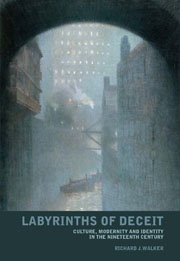Book contents
- Frontmatter
- Contents
- Acknowledgements
- Introduction: Tracing the fragments of modernity
- Part I (De)Generating doubles: duality and the split personality in the prose writing of James Hogg, Robert Louis Stevenson and Oscar Wilde
- Introduction
- 1 Speaking and answering in the character of another: James Hogg's private memoirs
- 2 He, I say – I cannot say, I: Robert Louis Stevenson's strange case
- 3 The psychopathology of everyday narcissism: Oscar Wilde's picture
- Part II The stripping of the halo: religion and identity in the poetry of Alfred Tennyson, James ‘B. V.’ Thomson and Gerard Manley Hopkins
- Part III Infected ecstasy: addiction and modernity in the work of Thomas De Quincey, Alfred Tennyson, Christina Rossetti and Bram Stoker
- Conclusion: Ghost-script
- Notes
- Bibliography
- Index
2 - He, I say – I cannot say, I: Robert Louis Stevenson's strange case
from Part I - (De)Generating doubles: duality and the split personality in the prose writing of James Hogg, Robert Louis Stevenson and Oscar Wilde
- Frontmatter
- Contents
- Acknowledgements
- Introduction: Tracing the fragments of modernity
- Part I (De)Generating doubles: duality and the split personality in the prose writing of James Hogg, Robert Louis Stevenson and Oscar Wilde
- Introduction
- 1 Speaking and answering in the character of another: James Hogg's private memoirs
- 2 He, I say – I cannot say, I: Robert Louis Stevenson's strange case
- 3 The psychopathology of everyday narcissism: Oscar Wilde's picture
- Part II The stripping of the halo: religion and identity in the poetry of Alfred Tennyson, James ‘B. V.’ Thomson and Gerard Manley Hopkins
- Part III Infected ecstasy: addiction and modernity in the work of Thomas De Quincey, Alfred Tennyson, Christina Rossetti and Bram Stoker
- Conclusion: Ghost-script
- Notes
- Bibliography
- Index
Summary
Modern bourgeois society with its relations of production, of exchange and of property, a society that has conjured up such gigantic means of production and of exchange, is like the sorcerer, who is no longer able to control the powers of the nether world whom he has called up by his spells.
As I came through the desert thus it was,
As I came through the desert: I was twain,
Two selves distinct that cannot join again.
In an attempt both to celebrate and contribute to the mythologized folk traditions of Scottish lowland life popularized by such luminaries as Walter Scott and Robert Burns, Robert Louis Stevenson, in his unfinished novel Weir of Hermiston, created four brothers known as the ‘Black Elliotts’. Ironically, in a novel where Stevenson aimed to engage with psychology, culture and historicity with greater veracity than in his previous fiction, Hob, Gib, Dandie and Clem have a largely symbolic function: they represent the stock virtues of the lowland, agrarian worker of Scotland. In the character of Dandie, Stevenson attempted to evoke the type of untutored, rural, poetic genius epitomized by James Hogg at the start of the nineteenth century; indeed, Stevenson notes of Dandie that ‘[t]he Ettrick Shepherd was his sworn crony; they would meet, drink to excess, roar out their lyrics in each other's faces, and quarrel and make it up again till bedtime’.
- Type
- Chapter
- Information
- Labyrinths of DeceitCulture, Modernity and Identity in the Nineteenth Century, pp. 68 - 90Publisher: Liverpool University PressPrint publication year: 2008

